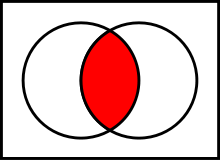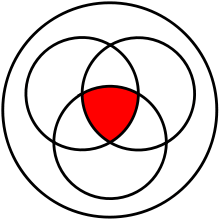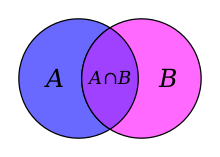Intersection (set theory)
In mathematics, the intersection of two sets A and B, denoted by A ∩ B, is the set containing all elements of A that also belong to B (or equivalently, all elements of B that also belong to A).[1]

Notation and terminology
Intersection is written using the sign "∩" between the terms; that is, in infix notation. For example,
The intersection of more than two sets can be written as
which is similar to Capital-sigma notation.
For an explanation of the symbols used in this article, refer to the table of mathematical symbols.
Definition


The intersection of two sets A and B, denoted by A ∩ B, is the set of all objects that are members of both the sets A and B. In symbols,
That is, x is an element of the intersection A ∩ B if and only if x is both an element of A and an element of B.
For example:
- The intersection of the sets {1, 2, 3} and {2, 3, 4} is {2, 3}.
- The number 9 is not in the intersection of the set of prime numbers {2, 3, 5, 7, 11, ...} and the set of odd numbers {1, 3, 5, 7, 9, 11, ...}, because 9 is not prime.
Intersection is an associative operation; that is, for any sets A, B, and C, one has A ∩ (B ∩ C) = (A ∩ B) ∩ C. Intersection is also commutative; for any A and B, one has A ∩ B = B ∩ A. It thus makes sense to talk about intersections of multiple sets. The intersection of A, B, C, and D, for example, is unambiguously written A ∩ B ∩ C ∩ D.
Inside a universe U one may define the complement Ac of A to be the set of all elements of U not in A. Now the intersection of A and B may be written as the complement of the union of their complements, derived easily from De Morgan's laws:
A ∩ B = (Ac ∪ Bc)c
Intersecting and disjoint sets
We say that A intersects (meets) B at an element x if x belongs to A and B. We say that A intersects (meets) B if A intersects B at some element. A intersects B if their intersection is inhabited.
We say that A and B are disjoint if A does not intersect B. In plain language, they have no elements in common. A and B are disjoint if their intersection is empty, denoted .
For example, the sets {1, 2} and {3, 4} are disjoint, while the set of even numbers intersects the set of multiples of 3 at the multiples of 6.
Arbitrary intersections
The most general notion is the intersection of an arbitrary nonempty collection of sets. If M is a nonempty set whose elements are themselves sets, then x is an element of the intersection of M if and only if for every element A of M, x is an element of A. In symbols:
The notation for this last concept can vary considerably. Set theorists will sometimes write "⋂M", while others will instead write "⋂A∈M A". The latter notation can be generalized to "⋂i∈I Ai", which refers to the intersection of the collection {Ai : i ∈ I}. Here I is a nonempty set, and Ai is a set for every i in I.
In the case that the index set I is the set of natural numbers, notation analogous to that of an infinite product may be seen:
When formatting is difficult, this can also be written "A1 ∩ A2 ∩ A3 ∩ ...". This last example, an intersection of countably many sets, is actually very common; for an example see the article on σ-algebras.
Nullary intersection

The conjunction of no argument is the tautology (compare: empty product); accordingly the intersection of no set is the universe.
Note that in the previous section we excluded the case where M was the empty set (∅). The reason is as follows: The intersection of the collection M is defined as the set (see set-builder notation)
If M is empty there are no sets A in M, so the question becomes "which x's satisfy the stated condition?" The answer seems to be every possible x. When M is empty the condition given above is an example of a vacuous truth. So the intersection of the empty family should be the universal set (the identity element for the operation of intersection) [2]
Unfortunately, according to standard (ZFC) set theory, the universal set does not exist. A fix for this problem can be found if we note that the intersection over a set of sets is always a subset of the union over that set of sets. This can symbolically be written as
Therefore, we can modify the definition slightly to
Now if M is empty there is no problem. The intersection is the empty set, because the union over the empty set is the empty set. In fact, this is the operation that we would have defined in the first place if we were defining the set in ZFC, as except for the operations defined by the axioms (the power set of a set, for instance), every set must be defined as the subset of some other set or by replacement.
See also
| Wikimedia Commons has media related to Intersection (set theory). |
- Complement
- Intersection graph
- Logical conjunction
- Naive set theory
- Symmetric difference
- Union
- Cardinality
- Iterated binary operation
- MinHash
References
- "Stats: Probability Rules". People.richland.edu. Retrieved 2012-05-08.
- Megginson, Robert E. (1998), "Chapter 1", An introduction to Banach space theory, Graduate Texts in Mathematics, 183, New York: Springer-Verlag, pp. xx+596, ISBN 0-387-98431-3
Further reading
- Devlin, K. J. (1993). The Joy of Sets: Fundamentals of Contemporary Set Theory (Second ed.). New York, NY: Springer-Verlag. ISBN 3-540-94094-4.
- Munkres, James R. (2000). "Set Theory and Logic". Topology (Second ed.). Upper Saddle River: Prentice Hall. ISBN 0-13-181629-2.
- Rosen, Kenneth (2007). "Basic Structures: Sets, Functions, Sequences, and Sums". Discrete Mathematics and Its Applications (Sixth ed.). Boston: McGraw-Hill. ISBN 978-0-07-322972-0.
External links
- Weisstein, Eric W. "Intersection". MathWorld.

